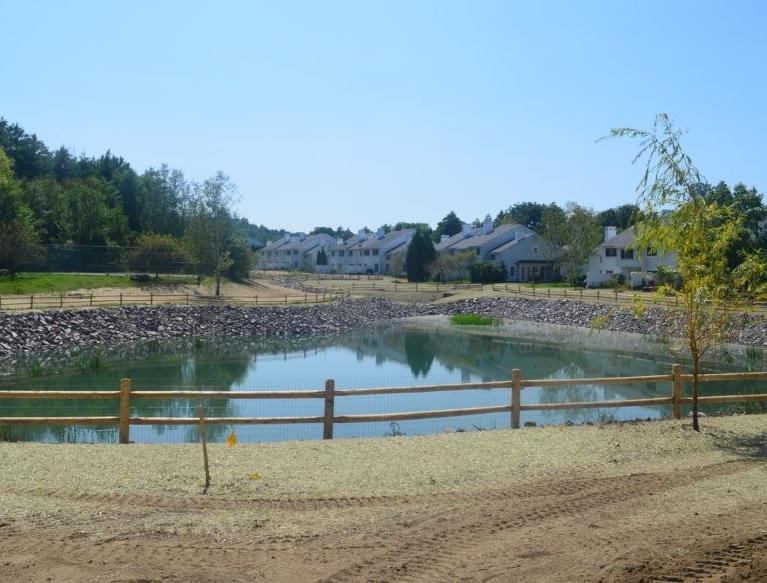
Testimony to Senate Natural Resources Committee
Regarding Changes to the 3-Acre Rule
Samantha Sheehan, Municipal Policy and Advocacy Specialist, VLCT
April 8, 2025
Changes to the 3-Acre Program
Only 177 of 677 3-Acre sites have received permits between 2019 and 2025, Serious concerns related to equity, the cost of treatment, and feasibility for developed areas persist.
VLCT seeks further changes to the 3-Acre Rule to:
Allow cost to be a factor in assessing feasibility and/or the engineering for treatment
Allow municipalities to separate publicly owned facilities (such as town roads) from private parcels under the permit
Remove dispersed residential neighborhoods without common ownership from 3-Acre regulation
- Only require treatment at the time of redevelopment.
- Protect municipal liability
What is a 3-Acre Site?
A 3-Acre site is an impervious surface of three or more acres that has never had an operational stormwater permit or was permitted to standards in place prior to the 2002 Stormwater Management Manual.
According to the ANR Stormwater Permitting Rule of 2019, a 3-Acre site is:
- a single tract of land with three or more acres of impervious surface;
- a project on a tract or tracts of land that was previously authorized under a stormwater permit that authorized the discharge of stormwater from three or more acres of impervious surface;
- impervious surface adjacent to or adjoining the foregoing types of impervious surfaces where the surface in question are part of a related operation, such as a hospital, resort, or campus.
3-Acre Parcel Acreage by Owner Type
Municipalities and School Districts together own 13.6% of acreage that is subject to the 3-acre rule.
| Owner | Acres | How Many Parcels |
| Federal | 69.75 | 2 |
| Municipal | 725.54 | 101 (includes schools) |
| Nonprofit | 149.77 | 14 |
| Private | 5270.4 | 594 |
| Public/Private | 7.6 | 2 |
| State | 246.15 | 19 |
| Trust | 33.54 | 7 |
| Grand Total | 6502.75 | 739 |
Acreage by County for Lake Champlain and Lake Memphremagog Watersheds
Addison: 450.63 acres
Bennington: 12.60 acres
Caledonia: 51.72 acres
Chittenden: 2539.33 acres
Essex: 42.17 acres
Franklin: 490.50 acres
Grand Isle: 35.63 acres
Lamoille: 465.25 acres
Orange: 26.18 acres
Orleans: 556.52 acres
Rutland: 962.04 acres
Washington: 754.97 acres
Windham: 108.24 acres
Windsor: 6.97 acres
Municipal Liability Related to 3-Acre for Residential Subdivision
Our 2025 Legislative Priorities include action to extend to municipal government the same protections from monetary liabilities that the legislature has enacted for the State.
The 3-Acre legislation as drafted would increase, not resolve, municipalities' general liability concerns
Liability for stormwater systems concerns include:
Property and casualty claims: stormwater treatment systems are large features and could include protruding caps and culverts, ponds and wetlands, grates, drains, steep grades, berms, retention walls, curbing, and rock-lined ditches.
Failure, maintenance, and replacement of the system
Landowner disputes, appeals, permit defense, etc.
Complications around enforcement due to municipal roads and lands sharing a permit
There is no monetary liability cap for municipal government.
Cost and Benefit
Cost of implementation must be a factor. The Clean Water Budget totals roughly $35 million per year from the Clean Water Fund and Capital dollars.
 Recent cost estimates shared with lawmakers are up to $112,000 per acre.
Recent cost estimates shared with lawmakers are up to $112,000 per acre.- Total costs for all 677 sites (6,500 acres)is in the ballpark of $700 million.
- $45.7M of ARPA was allocated towards 3-Acre Site stormwater compliance.
- Including $8.5 million to "permit obtainment assistance" for private and municipal sites, 24% of all 3-acre sites were awarded POA.
Regional Stormwater Utilities
There are 7 active stormwater utilities in Vermont: Burlington, South Burlington, Shelburne, St Albans City, St Albans Town, Williston Town. Another 4 are in the planning stage: Montpelier, Essex Junction, Proctor, and St. Johnsbury.
In our fall membership survey, VLCT inquired about the potential regionalization of a wide variety of municipal services. Of the 88 municipalities surveyed, 14% said stormwater services would be positively impacted, 33% said stormwater services would be negatively impacted by regionalizing.
Of those surveyed that also had a 3-Acre site, the highest reported obstacle to receiving a permit was a lack of funding for implementation, followed by competing priorities.
Municipal Impact Fees and Special Assessment Districts
VLCT generally supports expanding municipal authorities for local revenue setting.
However, for funding the treatment of impervious 3 Acre sites there are some impracticalities to consider with an impact fee or special assessment district funding strategy:
Generally, these fee types are used for enhanced public services, not in service to statewide goals or for broad public benefit
Would most likely only feasible when paired with substantial grant support (raising local matches)
Still ultimately places the financial burden on municipal government and ultimately taxpayers and rate payers
Only logical for residential subdivisions, not for municipal owned or privately owned single parcel 3 Acre sites
In some cases, may require a town vote
MS4s and Municipal Water & Sewer
13 communities have a Municipal Separate Storm Sewer System General Permit. About one third (1/3) of Vermont municipalities operate some water and/or sewer.
- The 2018 permit authorizes stormwater discharges within the Urbanized Areas of the following small MS4s: Burlington, Colchester, Essex, Essex Junction, Milton, Shelburne, South Burlington, Williston, and Winooski, the University of Vermont, and the Burlington International Airport.
- The designated small MS4s, within the stormwater impaired watersheds, are operated by the City of Rutland, the Town of Rutland, the City of St. Albans, the Town of St. Albans, and the Vermont Agency of Transportation
Competing Priorities: Stormwater Management for Flood Resiliency and Flood Recovery
More than 50 communities reported over $100 million damages from the 2024 floods.
Of the municipal entities impacted by a July 2024 severe storm, one third (1/3) make up 91% of the total estimated damages.
Two thirds (2/3) of the municipalities impacted were also impacted in July 2023. Of these, more than 80% have populations under 5,000.
Municipal Impact Fees and Special Assessment Districts
VLCT generally supports expanding municipal authorities for local revenue setting.
However, for funding the treatment of impervious 3 Acre sites there are some impracticalities to consider with an impact fee funding strategy:
- Generally, these fee types are used for enhanced services or amenities, not in service to statewide goals or for broad public benefit.
- Most likely only feasible when paired with substantial grant support (impact fees raise local matches).
- Places the financial burden on municipal government and ultimately taxpayers and rate payers.
- Only logical for residential subdivisions, not for municipal owned or privately owned single parcel 3 Acre sites.
- In some cases, may require a town vote.